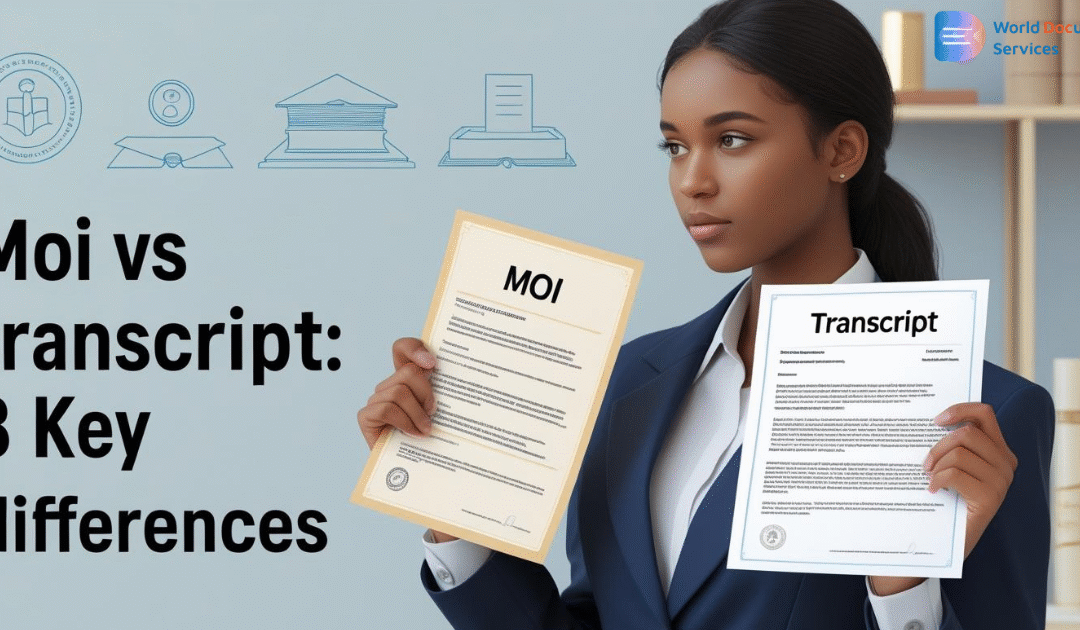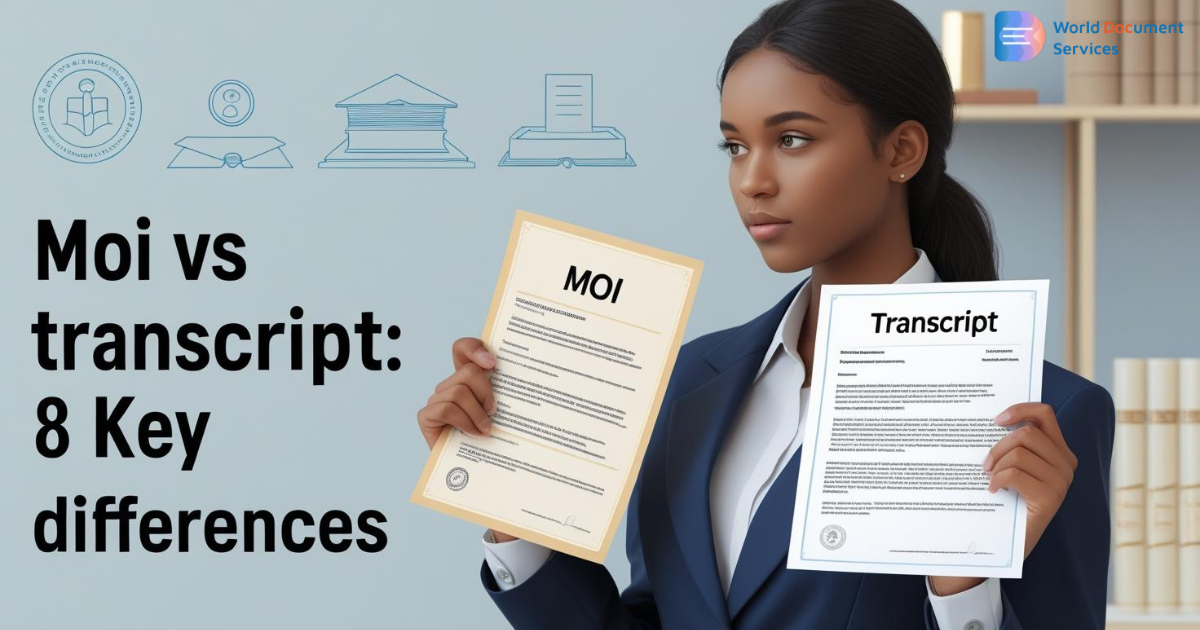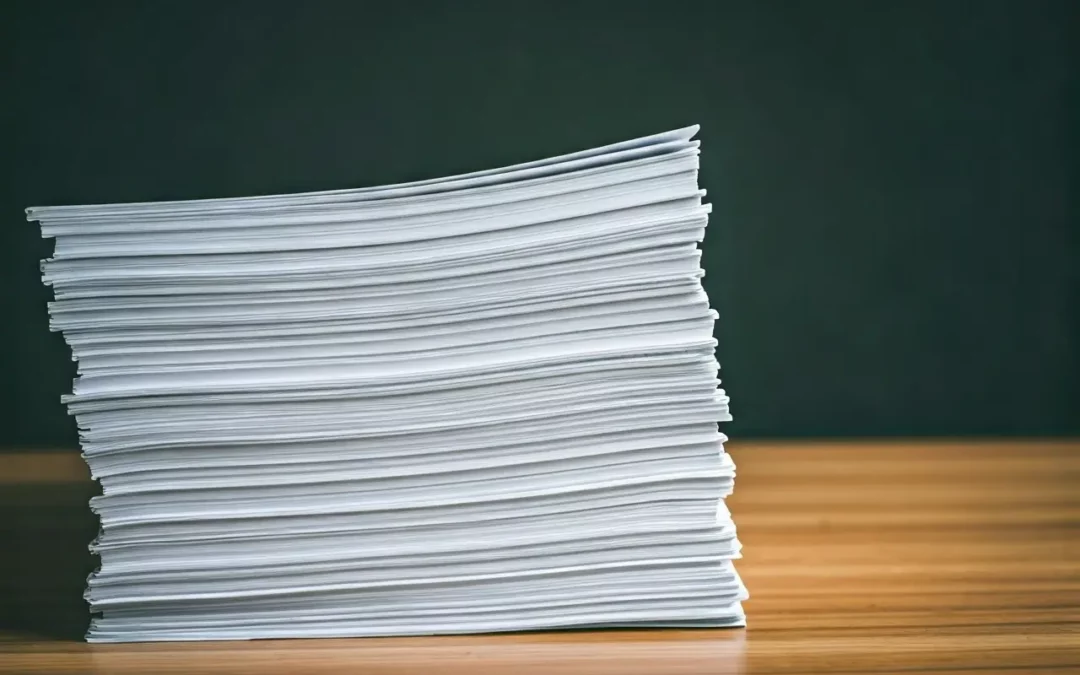
by World Document Services | Jul 17, 2025 | Most Viewed, Transcripts Services

In the professional and educational field, it is necessary to verify educational credentials. Among the most important elements of such verification are the Medium of Instruction (MOI) certification and transcript authenticity verification. While both are proof of academic credentials, each plays a different role, with varying requirements and repercussions.
Need help with your MOI certification and transcript authenticity verification? Contact Us Now!
This article examines the eight key differences between MOI certifications and transcript authenticity, giving students, professionals, and employers insight into their relevance.
1. Definition and Purpose:
The Medium of Instruction (MOI) certificate is a certificate issued by an educational institution to confirm the language in which the student is educated. It is typically demanded for international university admission or visa applications for the purpose of demonstrating proficiency in a specified language, most often English.
In comparison, transcript authenticity verification ensures whether a student record is original and not tampered with. The verification is required for employment, higher education, or immigration.
2. Authority to Issue:
MOI certificates are issued by the educational institution where the student has completed their studies. It is generally provided by the university’s administration or the registrar’s office upon request. However, in the case of an autonomous institute, it is directly issued by the institution itself.
The authenticity of the transcript is confirmed by the issuing university or by official credential evaluation agencies. This is part of the process of university transcript authentication, whereby the authenticity of the academic records is confirmed.
3. Requirement for Verification:
In the MOI certificates, verification is generally straightforward. The school only confirms that the student has studied in the given language.
Authentication of the transcript, however, requires a strict document authentication process. Employers, institutions, and credential evaluation organizations check for any evidence of forgery, inconsistent grades, or inconsistencies in the record.
4. Purpose in Immigration and Higher Studies:
Some immigration authorities, as well as many international universities, require an MOI certificate in the absence of the results of standardized tests such as IELTS or TOEFL in order to determine English proficiency.
In contrast, transcript authenticity verification is typically mandated by educational credential assessment (ECA), which further evaluates whether a foreign degree in another country is equivalent. This is particularly pertinent for immigrants planning to go to countries like Canada, the US, and Australia.
5. Sections of the Document:
An MOI certificate typically includes the following information:
- The student’s name
- The course or program title
- The mode of instruction
- The university seal and signature
A transcript certificate or certified transcript consists of:
- Comprehensive grade-wise subjects.
- Credit hours.
- Awarded degree.
- Date of graduation.
- University seal and authorized signatures.
6. Evaluation by Credentialing Agencies
While MOI certificates may be recognized by international institutions, they are not always a primary document for equivalency in higher education. They may be used to support an application, but are by no means always required.
Authenticity verification of the transcript, however, is part of the educational credential evaluation process. Institutions, including WES (World Education Services) and ECE (Educational Credential Evaluators), evaluate international academic and professional recognition for transcripts.
7. Acceptance by Employers and Universities
Universities and employers typically request transcript authenticity for formal verification of academic credentials. An MOI certificate alone is not confirmation of degree completion.
However, an MOI certificate may be useful when applying for language-specific jobs or admissions in which English proficiency certification is the requirement in place of language exam results.
8. Time Required for Processing and Cost
It is quicker and less costly than the certification of transcripts. Universities generally take a few working days to produce MOI certificates, sometimes for free or for a nominal charge.
University transcript verification procedures can take several weeks. Additional charges may be necessary for verification services, courier services, and independent evaluation.
FAQs
Q: Can I use an MOI certificate instead of an English language proficiency test?
A: Yes, a number of universities and immigration agencies accept MOI certificates as proof of English proficiency, although the requirements vary by institution and by country.
Q: How long will it take to authenticate the transcripts?
A: The transcript verification process can take anywhere from several weeks to only a few days, depending on the verification agency and the institution.
Q: Is transcript authenticity verification mandatory for job applications?
A: Although it is not always required, most employers ask for transcript authenticity verification for senior positions to ensure academic credentials are genuine.
Q: Do MOI certificates come from any university?
A: Most institutions provide MOI certifications, though the policies differ. It is best to check with the administrative office of the university.
Q: What happens if my transcript is found to be unauthentic?
A: If a transcript fails the transcript authenticity verification process, employment, immigration, or university applications can be rejected, and legal actions can be taken in the case of fraud.
Conclusion
While MOI certificates and transcript authenticity verification both serve significant purposes in the professional and academic fields, each serves a different purpose. MOI certifications are primarily for the purpose of language of instruction identification, while transcript authenticity verification verifies the authenticity of academic records. Having knowledge of the difference can help students and professionals make it through admissions, employment applications, and immigration procedures with ease.
Download the World Document Services App
You may enjoy a hassle-free experience by downloading our mobile app from either the App Store or the Play Store. It works with both iOS and Android devices.

by Shipra Choudhary | Feb 13, 2025 | Most Viewed, Transcripts from University

When applying for education credentials evaluation (ECA), ensuring that all your documents are accurate and comprehensive is crucial. One vital document in this process is the JNTU Kakinada transcript. In this blog, we’ll discuss what makes these transcripts indispensable for ECA.
In today’s globalised world, pursuing higher education or professional opportunities abroad has become a common goal for many students and professionals. But there is often a very important step missing when people move to a different country for work or learning—the Educational Credential Assessment (ECA). Getting your university transcript is a very important step for graduates of Jawaharlal Nehru Technological University (JNTU) Kakinada. We will talk about why JNTU transcripts for ECA are important, how they’re processed with the Educational Credential Assessment process, and what you need to know about the JNTU Kakinada transcript process.
Need help with your JNTUK Transcript? Contact Us Now!
What Are JNTU Kakinada Transcripts?
They serve as the university’s official records of a student’s academic achievements—courses taken, grades earned, credits gained, and degree awarded are all listed on these transcripts. Transcripts are complete and standardised, unlike mark sheets or provisional certificates. This means that they can be used for both academic and professional reasons.
Transcripts from JNTU Kakinada show that a student or employee has completed their education and can be used to move or study abroad. They are often needed by foreign employers, colleges, and immigration officials to make sure that an applicant’s academic credentials are real and equivalent.
Read more: Why Accurate JNTUK Transcripts are Crucial for Your Overseas Education Dreams
What Is Educational Credential Assessment (ECA)?
Countries such as Canada, the USA, Australia, and others use Educational Credential Assessment (ECA) to check the educational credentials of individuals who have studied in other countries. An ECA checks to see if degrees, diplomas, or awards from other countries meet the educational requirements of the host country.
How to Obtain JNTU Kakinada Transcripts for ECA?
You should follow these steps to get your transcripts with ease:
Step 1: Get the Documents you need
Make sure you have these things ready before you request transcripts:
- A copy of your degree
- Marksheet for every semester
- A valid ID from the government
- A letter requesting transcripts
Step 2: Visit the JNTU Kakinada Website
Go to the JNTU Kakinada website and find the area for transcripts. You can download the transcript application form or, if possible, request it online.
Step 3: Complete the Application Form
Give accurate details on the application form about yourself, the courses you’ve taken, and why you need the transcripts (for example, Transcripts for WES evaluation).
Step 4: Pay the Fee for Transcript
You need to pay the fee for getting the transcript. Depending on the number of copies you require and the delivery method (e.g., regular or express), this fee may vary.
Step 5: Send in your Application
Send your filled-out application form to the university’s transcript office along with the necessary papers and proof of payment.
Step 6: Tracking your Application
After you send in your application, check back to see how it’s doing. Most universities have a way to keep track of things on their websites or through email updates.
Step 7: Receive Your Transcripts
If you want, your transcripts will be sent directly to the ECA organisation you chose (like WES) or to your home address once they are ready.
Tips for a Smooth JNTU Kakinada Transcript Process
Follow these suggestions so that you have a smooth experience:
1. Start Early
It can take a few weeks to get your transcripts, so start early to keep your ECA application from being held up.
2. Double-Check Your Application
All information on your application form should match the university’s records.
3. Communicate with the University
Don’t be afraid to ask for help from the JNTU Kakinada transcript office if you have any questions or worries.
4. Choose the Right Delivery Method
If you need your transcripts quickly, choose express service.
5. Keep Copies for Your Records
Keep copies of your records and other academic records at all times in case you need them later.
Common Challenges and How to Overcome Them
The process for getting a JNTU Kakinada transcript is simple, but some students may have trouble. Here are some commonly encountered issues and how to resolve them:
1. Delays in Processing
Processing transcripts can take a while, especially when there are a lot of them. Don’t wait; apply early and keep in touch with the university on a daily basis.
2. Incorrect Information
It can be hard to get through the ECA process if your documents have mistakes. Check your application again, and when you get your transcript, look them over carefully.
3. Lost or Misplaced Documents
If you’ve lost your marksheet, diploma, or degree, you should call the university right away to get new ones.
4. Delivery Issues
Get in touch with the university and the delivery service right away if your transcripts get lost in the mail.
Read more: 10 Things to Look for When Choosing Online Transcript Services in India, Canada, and the USA
Conclusion
Getting JNTU Kakinada transcripts for ECA is a necessary step for students and employers who want to look for work abroad. These transcripts are legal proof of your academic credentials and are an important part of the process of evaluating your credentials. By reading this blog and knowing how to get a transcript from JNTU Kakinada, you can make sure that your ECA application goes smoothly.
At World Document Services, we help students and professionals with things like verifying documents, getting transcripts, and applying for ECA. You can get help from our team of experts if you need to verify your JNTU Kakinada degree or look over your Transcripts for WES. Our goal is to make your journey abroad as easy as possible.
Download the World Document Services App.
You may enjoy a hassle-free experience by downloading our mobile app from either the App Store or the Play Store. It works with both iOS and Android devices.
FAQS
Q: Do I Need JNTU Kakinada Transcripts for College Admissions?
A: Yes, most colleges and universities need to see your transcripts to make sure they can trust your academic history and success. This is especially true for programs that offer scholarships or competitive extracurricular activities.
Q: How Do JNTU Kakinada Transcripts Affect My Eligibility for ECA?
A: They indicate that you have completed the required coursework, which may be needed to join some ECAs. Many ECAs have minimum GPA requirements for participants, and your record can help show that you meet those standards.
Q: Can JNTU Kakinada Transcripts be Used for International Applications?
A: Yes, they are usually needed when going to college, an internship, or a job abroad because they prove that you have the right academic credentials.
Q: How Can I Obtain My JNTU Kakinada Transcript?
A: You can get your transcripts from the official JNTU Kakinada website or by going to the university’s examinations office. There may be steps that need to be taken, like filling out a form and paying a fee.
Q: Is There a Minimum Grade Requirement for ECA Participation?
A: Some extracurricular events might need a certain grade point average or GPA. You can see if a student meets these requirements by looking at their transcripts before they can join an ECA.





 Call Us
Call Us Mail Us
Mail Us WhatsApp
WhatsApp
